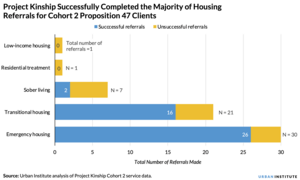
(adamkaz/Getty Images)
Four Ways to Improve Reentry for Formerly Incarcerated People with Behavioral Health Needs
This post was originally published on Urban Wire, the blog of the Urban Institute.
Research shows that in 2018, nearly 570 of every 10,000 formerly incarcerated people experienced housing insecurity upon release. And one study found homelessness is between 7.5 to 11.3 times more prevalent (PDF) within the population of people incarcerated in jails.
This is largely because formerly incarcerated people face barriers to affordable and stable housing (PDF), including lack of income at release, difficulty qualifying for rental properties because of criminal records, and restrictions on living in public housing (PDF) for people convicted of certain offenses.
This is particularly true for people with behavioral health needs, who face the dual challenges of accessing treatment for mental health needs and substance use disorders and finding stable housing. People without stable housing may have more difficulty accessing mental health and substance use disorder treatment, which compounds their housing instability.
Recognizing the link between housing instability and behavioral health needs for formerly incarcerated people, California developed a unique grantmaking program to support this population through Proposition 47.
Also known as the Safe Neighborhoods and Schools Act, Proposition 47 reduced some of the state’s low-level drug possession and property felonies to misdemeanors, which led to a reduction in spending on incarceration. The state’s Board of State and Community Corrections (BSCC) distributes those savings in the form of competitive grants to public agencies to provide mental health services, substance use disorder treatment, or diversion programs for justice-involved people. Since 2017, the BSCC has allocated nearly $200 million in funding to government entities across the state for two cohorts of grants.
The Urban Institute is evaluating Orange County’s Proposition 47 program. Findings from our final evaluation of Cohort 1 services and the interim evaluation of Cohort 2 services show Orange County’s approach to providing reentry services has largely been successful. As the BSCC prepares to distribute a third cohort of funding of more than $143 million, county agencies and service providers can implement lessons learned from Proposition 47 programs over the past five years to promote successful reentry.
Orange County’s Proposition 47 services
Under Proposition 47, the Orange County Health Care Agency (HCA) received two rounds of funding to reduce the number of people with mild-to-moderate mental health and substance use disorders incarcerated in the county jail.
The HCA’s innovative approach to reentry begins while people are incarcerated. Through Proposition 47, the HCA created system navigators, or county representatives that meet with potentially eligible people (those diagnosed with a mild-to-moderate mental health or substance use disorders and in jail for an eligible offense), shortly before they are released from the Orange County jail system. During these inreach meetings, system navigators assess immediate reentry needs, share information on available housing and treatment services, and make referrals to Proposition 47 services.
Upon release from the county jail, people meet with peer navigators—staff with lived experience employed by Orange County’s main Proposition 47 community-based service provider, Project Kinship. Peer navigators provide basic services, such as charged phones, bus passes, and clothing, as well as warm handoffs to Proposition 47 services at a reentry hub called the Community Support and Recovery Center. At the center, which was established through Project Kinship, staff provide formerly incarcerated people with intensive case management, job skills training, substance use disorder and mental health treatment, and housing placement assistance.
Recognizing the acute need for housing support in Orange County, the HCA and Project Kinship focused on increasing housing capacity for clients in the second round of Proposition 47 funding. In total, Project Kinship has provided 581 referrals to housing services for clients. Of the approximately 60 housing referrals made in the first nine months of Cohort 2 services, about 73 percent of referrals resulted in a successful placement (PDF).
Lessons learned from Proposition 47 services
Reentry providers can implement the following lessons from Orange County’s Proposition 47 program as they develop services to meet the needs of formerly incarcerated people.
- Enable warm handoffs to postrelease services.
The combination of inreach system navigators and peer navigators outside the county jail ensures nearly all eligible people released from the county jail system are informed of available services. These interactions allow people to get to know Project Kinship and its resources before they step into their office. Providing transportation from the jail directly to Project Kinship for people who need immediate support creates a seamless transition between screening, enrollment, and program participation.
- Centralize information on reentry resources.
The reentry hub bridges existing system components and fills gap in county services, which has been integral to success. In addition to in-house mental health and substance use disorder counseling, Project Kinship staff make referrals to outside services such as recovery residences and county-run mental health programs. Staff also support the employment needs of clients by providing placement assistance and résumé-building courses and more. Project Kinship also hosts other service providers and agencies on site to consolidate services at a single location and improve access.
- Recognize that housing needs for formerly incarcerated people vary.
The diverse housing resources available through Project Kinship—including transitional housing, emergency housing, residential treatment, sober living, and low-income housing—allow Project Kinship staff to stably place clients in housing, enabling them to deliver more consistent wraparound reentry services.
- Build relationships across organizations.
Project Kinship’s dedicated housing coordinator and case managers meet biweekly with various housing providers to maintain relationships and ensure the success of Proposition 47 clients housed through each agency. This includes a partnership for dedicated beds at a long-term transitional housing site and the county’s sober living providers. The public defender’s office also sends a paralegal to work at Project Kinship one day a week to provide legal assistance services (this transitioned to phone support during the COVID-19 pandemic). These relationships bridge the gap in services that Project Kinship can’t provide and are integral to Project Kinship’s wraparound services approach.
Orange County’s Proposition 47 program shows there’s no one-size-fits-all solution to reentry and that stable housing is critical. Other reentry programs serving people with behavioral health needs can take a similar, multifaceted approach to ensure residents have access to the services they need to succeed.



